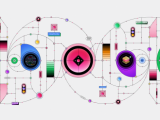
Autonomous driving: Those who want to stay in the game will have to dig deep into their coffers
27. August 2021Autonomous driving: Those who want to stay in the game will have to dig deep into their coffers
San Francisco, 8/27/021
When it comes to autonomous driving, Elon Musk doesn’t rely on outside companies. This is the consequence of his experience with the current chip crisis: as soon as a supply chain breaks somewhere, production comes to a standstill. Losses are imminent. Such a thing will not happen to Tesla and its customers, because the new computer chip, which runs on the Dojo supercomputer and is to be used to train the AI network for automated driving, will be manufactured in-house by Musk. To that end, Musk announced: The „D1“ chip will be manufactured in a 7nm fabrication process and will have a computing power of 362 teraflops. (See below for explanation)
According to Musk, the Dojo chip should be ready for use by 2022. It will not be limited to Tesla vehicles . Because there are likely to be „other applications that will make sense,“ he added.
So what are these computing behemoths good for? The chips help Tesla’s built-in AI software make decisions based on what the cameras see on the road.
For the Autopilot hardware, 25 chips are placed on a single training tile, and 120 tiles combine to form multiple server racks, giving the system over one exaflop of performance.
Tesla reaffirmed its commitment to using computer vision as the only approach to autonomous driving. A sophisticated neural network infrastructure enables Tesla computers to operate semi-autonomously anywhere in the world.
This sets the company apart from Waymo, Aurora, Cruise and other competitors that use lidar and radar in their autonomous systems. Tesla’s purely visual system consists of eight mounted cameras that process 3D „vector spaces“ in real time.
Tesla’s head of AI, Andrej Karpathy, likened it to developing an animal that can sense its surroundings and act intelligently based on what it sees.
At AI Day, he showed videos of Tesla vehicles navigating parking lots and traffic, and talked about how the company’s neural networks have evolved over time.
Tesla continues to work on solving the problem of on what basis the autonomous vehicle can make the optimal decision when Autopilot is blocked from view by other cars. In this case, the system will rely on saved signs and markers from previous trips. This, too, requires enormous computing power.
Tesla has solved this problem in part by using a spatially recurring network video module that creates a data cache that the car can use for road predictions.
Waymo says its autonomous vehicles have now logged 20 million miles on public roads and 20 billion miles in simulations. The news comes after Alphabet’s self-driving arm announced plans to build a center for its autonomous semi-trucks in Texas.
Waymo seems to be in this competition: who offers the safest autonomous vehicle ? Above all, to put on infinite miles driven and the data collected in the process. For example, the company’s executives said that its driver AI system can now recognize and adapt to the behavior of other drivers. It is also able to determine the difference between stop signs and their reflections, it said. Even recognizing small objects in the distance is no longer a problem, it said.
Waymo began testing in San Francisco in 2009. Its AVs now collect data from more than 100,000 miles of city streets each week.
In June, Waymo announced it had received a $2.5 billion funding round from investors Alphabet, Silver Lake, Andreessen Horowitz, Tiger Global and AutoNation. The funds will go toward expanding the team and advancing autonomous driving technology. Waymo is also opening a new office in Pittsburgh, where talent from Carnegie Mellon University is transforming the city into a hub for autonomous vehicles. Aurora, Motional and Argo AI already have offices there.
KiloFLOPS (kFLOPS) = 10^3 (1,000) FLOPS
1. megaFLOPS (MFLOPS) = 10^6 (1,000,000) FLOPS
2. gigaFLOPS (GFLOPS) = 10^9 (1,000,000) FLOPS
3. teraFLOPS (TFLOPS) = 10^12 (1,000,000,000) FLOPS
4. petaFLOPS (PFLOPS) = 10^15 (1,000,000,000,000) FLOPS
5. exaFLOPS (EFLOPS) = 10^18 (1,000,000,000,000,000) FLOPS
6. ZettaFLOPS (ZFLOPS) = 10^21 (1,000,000,000,000,000,000) FLOPS
7. YottaFLOPS (YFLOPS) = 10^24 (1.000.000.000.000.000.000) FLOPS
Tera, like kilo, is a measure of size. Kilo stands for the factor 10^3 or 1,000: Because 1,000 meters is a kilometer, 1,000 grams is a kilogram and 1,000 FLOPS is a kiloFLOP.
Tera stands for a factor of 10^12, so TeraFLOPS stands for a trillion calculations per second.
The acronym FLOPS comes from English and means „Floating Point Operations Per Second“. It is therefore „floating point operations per second“.


